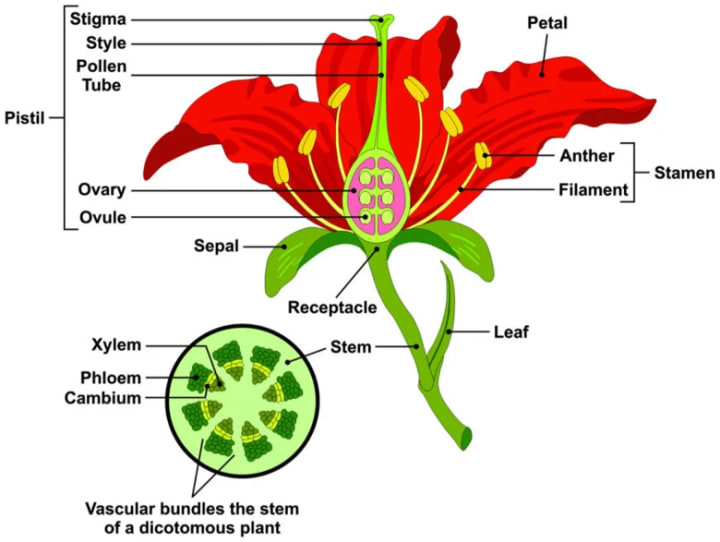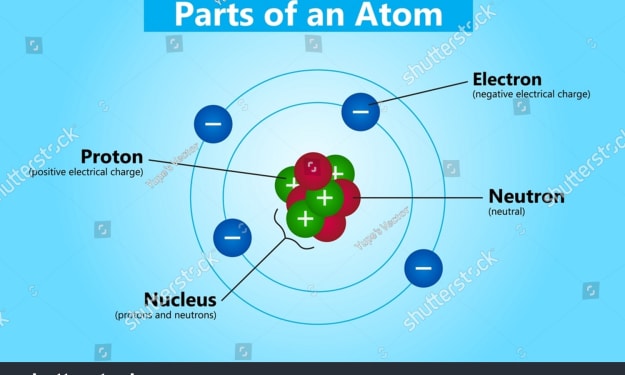THE STRUCTURE AND FUNCTION OF PARTS OF A FLOWER.
Flower 🌸


Introduction:
The flower is the most attractive part of most plants; flowers that are pollinated by animals have brightly colored petals and those pollinated by wind have less brightly colored petals. Flowers undergo two types of pollination referred to as cross-pollination and self-pollination; most flowers that undergo self-pollination are referred to as perfect flowers because they have both male and female sex organs; and some flowers that undergo cross-pollination have one sex organ responsible for reproduction and they are referred to as imperfect flowers.
What is a Flower?
Simply defined, a flower is the reproductive part of a plant. There are perfect and imperfect flowers; flowers are made of many parts that enable them to survive, function, and reproduce. The various parts of a flower are uniquely designed by nature to enable them to carry out their specific function.
Parts and Functions of a Flower
In this section, we will be looking at a complete flower (sometimes referred to as a perfect flower). A complete flower has many parts that are uniquely designed by nature to enable them to carry out their functions for the survival of the plant. Parts of a complete flower are the anther and filament known as the stamen; the stigma, ovary, ovule, and style also known as the pistils; the petal, calyx/sepal, and stalk.
Functions:
1. The stamen is the male reproductive part of the flower and comprises of the anther and the filament.
-The Anther: It is the male sex organ of a complete flower responsible for producing and releasing the male sex cell called the pollen grain.
-The Filament: It is a long structure that supports and holds the anther in position.
2. The Pistil, also referred to as the carpel, comprises components of the female reproductive parts of a flower. It comprises of the stigma, style, ovary, and ovule.
-The Stigma: It is a sticky structure located at the top of the style; it receives pollen grains from the anther.
-The Style: The style connects the stigma and the ovary; it serves as a support to the stigma and as a passageway for pollen through a pollen tube from the stigma to the ovule located in the ovary.
-The Ovary: The ovary produces and contains the unfertilized seed known as the ovule which is located centrally at the base of the carpal. Pollen grains from the stigma fertilize the ovule; it is the fertilized ovule that develops into a fruit.
-The Ovule: After fertilization, the ovule develops into the seed.
3. The Pedicel/Stalk: It is the secondary structure of a flower that develops from the stem; it is in only flowers with inflorescence in the form of clusters at the top that have a pedicel.
4. The Receptacle: It is located at the top of the stalk and the base of the flower; its main function is to support the weight of the flower and to connect the flower to the stalk.
5. The Sepal/Calyx: The word calyx refers to the collective name of several sepals; it is the first part of the flower that develops and is located on top of the stalk. The main function of the sepal is to protect the flower from losing water in its budding stage.
6. The Petal/Corolla: The petal is the most brightly colored part of a flower, because of its brightness, it attracts pollinators to carry out pollination; the word corolla is the collective name for several petals. The petal is the part of flowers that has a variety of types ranging from color, shape, and size.
WHAT IS POLLINATION, THE TYPES OF POLLINATION, AND FERTILIZATION.
Pollination: It is defined as the transfer of pollen grains from the anther of a flower on the same plant or the transfer of pollen grains from the anther of a flower on a plant to the stigma of a flower of another plant.
TYPES OF POLLINATIONS.
There are two types of pollination, namely: Self-pollination and Cross-pollination.
Self-pollination: It is the transfer of pollens from the anther of a flower on a plant to the stigma of a flower on the same plant.
Cross-pollination: It is the transfer of pollen from the anther of a flower on a plant to the stigma of a flower on another plant.
AGENTS OF POLLINATION
There are two main agents of pollination: they are wind and animal pollitants.
Wind/Air Pollination: It is the transfer of pollen grains from the anther of a flower on a plant to the stigma of a flower on the same plant or different plant. This type of pollination requires pollen grains that are light in weight to be easily carried by wind/air; plants with flowers that are not brightly colored; plants with long and slanted filaments; and larger and sticky stigmas to capture more pollens.
Animal Pollination: It is the type of pollination that requires the transfer of pollen grains from the anther of a flower on a plant to the stigma of a flower on the same or different plant. Flowers that are modified to carry out animal pollination have brightly colored petals and sweet-scented nectar to attract animals, short filaments, and less broad and sticky stigmas.
Conclusion: Flowers contain unfertilized seeds that when fertilized can develop into a fruit that is edible or non-edible. We use flowers for decorations, as a gift to express our love to our loved ones, it can be used to produce perfume, etc. Flowers can be grown to beautify our homes and to produce sweet-scented fragrances; flowers with sweet nectars attract birds and inserts for both beauty and pollination purposes. We should grow our favorite flowers in our backyards to maintain their existence.
Author: Sekou Sesay

About the Creator
Sekou Sesay
Love






Comments
There are no comments for this story
Be the first to respond and start the conversation.